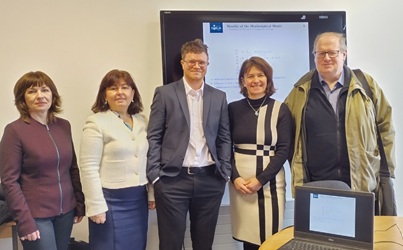29/11/24 Seminar: Jack Lyons

Jack Lyons (TU Dublin) will speak at the School of Mathematics & Statistics seminar series on Friday 29 November 2024.
| Speaker: | Jack Lyons (TU Dublin) |
| Title: | Mathematical Modelling of Photonic Structures for Environmental Sensing |
| Date: | 1pm, Friday 29 November, 2024 |
| Location: | TU Dublin, Grangegorman, Central Quad, CQ-205 (Tea, coffee and sandwiches at 12:30pm in room CQ-205) |
|
Abstract: In recent years, there has been increased interest towards hybrid photopolymers, experimental researchers at TU Dublin have been particularly interested in acrylamide-based photopolymers doped with zeolite nanoparticles. The reasons for this interest are threefold: first, nanocomposites allow for greater flexibility in achieving the desired material properties since one can tune the properties of the different components independently; second, it has been demonstrated in the literature that the incorporation of nanoparticles in photopolymers reduces the amount of shrinkage of which they normally suffer; third, by adding nanoparticles it is possible to functionalise the materials and the structures recorded in them and thus use them in, for example, optical sensing. Previously reported results from experiments with the new hybrid holographic materials doped with nanozeolites have revealed some positive features: reduced photopolymerization-induced material shrinkage and a non-linear increase in refractive index modulation in response to increased concentration of inorganic nanoparticles which existing mathematical models are not capable of predicting. This research reviews the existing mathematical models and builds on them by incorporating: new equations to describe the spatial redistribution of inorganic nanoparticles during holographic recording; cross-diffusion in the mass transport of monomer and short polymer chains; scattering of light from inert nanoparticles; Bragg angle detuning due to shrinkage during holographic recording of slanted gratings; and absorption of light within the finite depth of the nanocomposite. Where earlier models restricted analysis to the distance across the grating period, the last two aforementioned improvements require analysis to be extended to the depth within the nanocomposite. The model is validated via a comparison of numerical simulations of the model equations with existing experimental data. The model has successfully predicted the change in refractive index modulation in response to increased doping of inorganic nanoparticles and the increased shrinkage at high spatial frequencies. The results predicting the effect of the nanoparticle refractive index on the final refractive index modulation of the grating are very useful for guiding the design of holographic recording materials. This is particularly important where high diffraction efficiency optical structures are needed in thinner polymeric layers. In the context of environmental sensors, this would ensure a faster response time and larger operational angles. Furthermore, the final condition of this model is used as the initial condition for a second mathematical framework modelling the diffusion of target analytes in a holographic grating and the resulting change in optical properties. The end product of this research is a mathematical model which can offer some insight into how properties of the photopolymer, the recording conditions and nanoparticle properties can be used to optimize holographic gratings recorded in hybrid photopolymer materials for the purpose of holographic sensor functionality by quantifying the refractive index modulation sensitivity to nanoparticle concentration and minimizing both distortion and shrinkage. A systematic approach to the fabrication of novel hybrid materials based on mathematical and computational modelling will significantly shorten the design phase. The analytic characterization of such materials can be translated into practical recommendations, leading to direct and immediate impact on the applied research in holographic sensors. Based on joint works with Dana Mackey and Izabela Naydenova |
|
Postscript: Congratulations to Jack who successfully defended his doctoral thesis at the end of December 2024. Jack was commended for his deep understanding of the subject and his engagement in the discussion with the examiners.

Left to right: Tatsiana Mikulchyk (TU Dublin), Izabela Naydenova (TU Dublin), Jack Lyons, Dana Mackey (TU Dublin), Martin Meere (NUI Galway)
